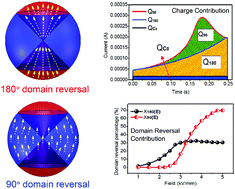Quantitative studies of domain evolution in tetragonal BS–PT ceramics in electric poling and thermal depoling processes
Abstract
Bismuth scandate-lead titanate (abbreviated as BS–PT) ceramics are a promising piezoelectric material for high temperature applications because of their excellent piezoelectric performance as well as high Curie temperature. The piezoelectric properties of ferroelectric materials are closely related to the microscopic domain structure; however, quantitative analysis on domain evolution as well as its effect on materials properties in both electric poling and thermal depoling processes is seldom revealed. In this work, we investigate the effects of electric poling and thermal depoling on the domain structure and piezoelectric performance in tetragonal BS–PT ceramics. Based on an early study by Uchida and Ikeda, a modified model is developed to quantitatively study both 180° and 90° domain reversals during the electric poling process. To obtain a clear correlation between the domain structure and piezoelectric properties, quantitative estimation of 90° domain reversal in both electric poling and thermal depoling processes is done by an XRD method. The present work provides a comprehensive insight into domain evolution of tetragonal BS–PT ceramics, which is also of heuristic significance to other perovskite piezoelectric ceramics.



 Please wait while we load your content...
Please wait while we load your content...
